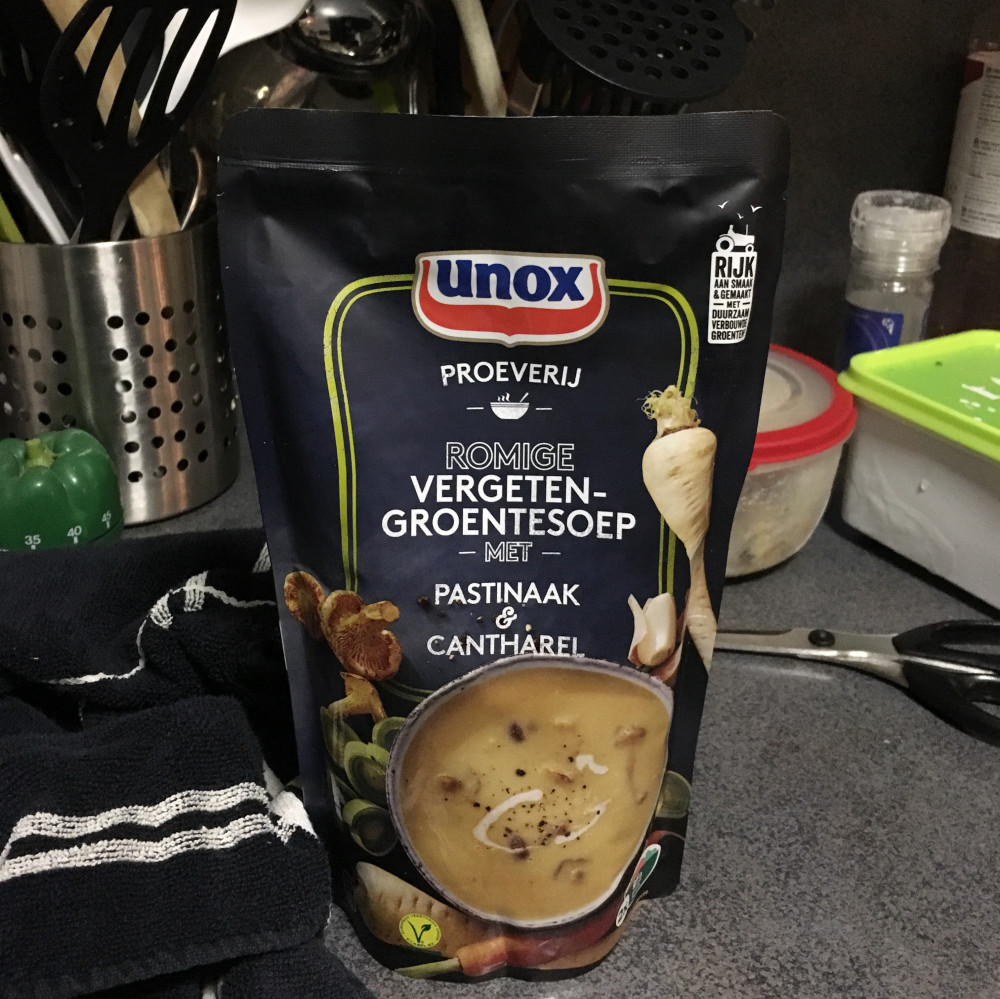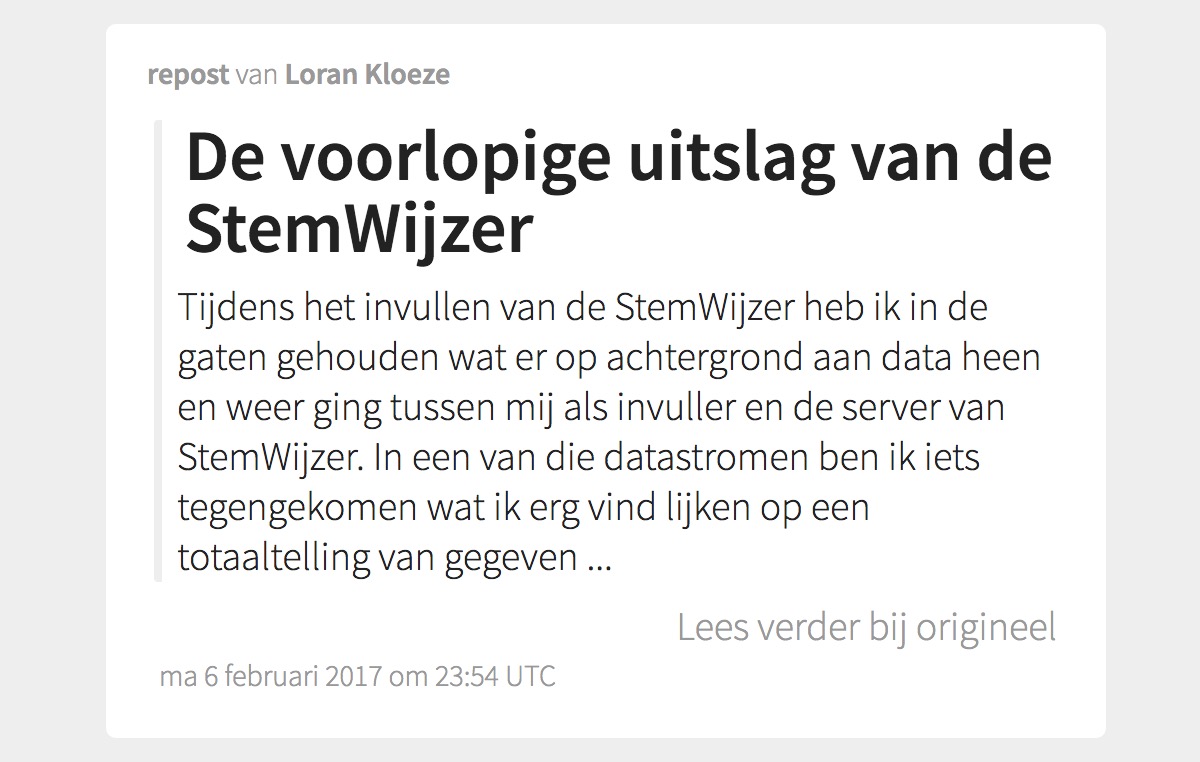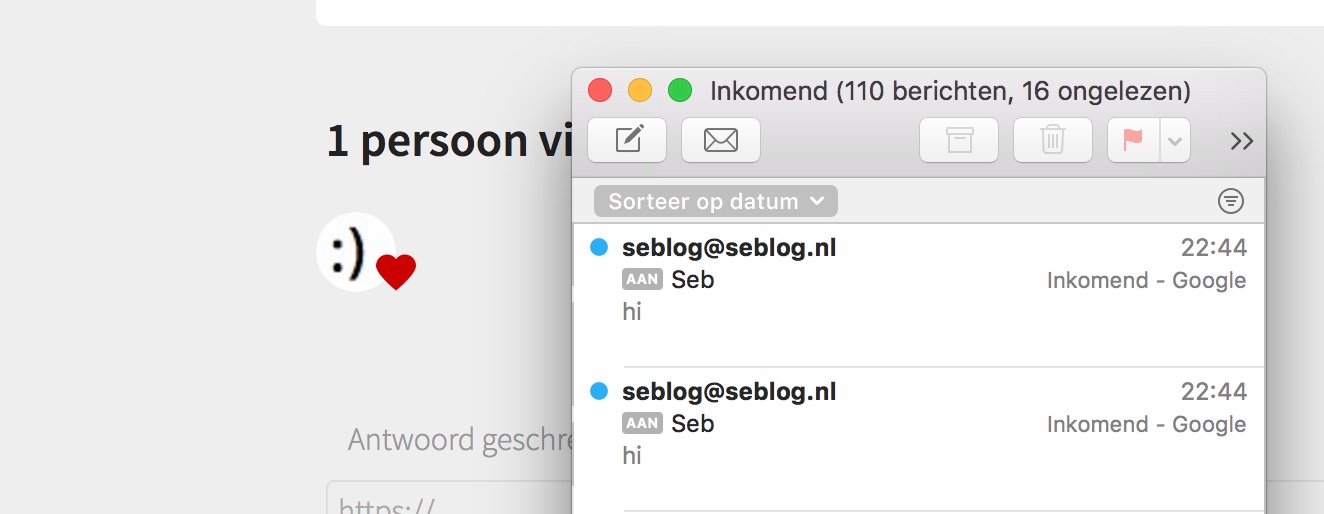 Seb vindt dit leuk.
Seb vindt dit leuk.Seblog.nl
 Seb vindt dit leuk.
Seb vindt dit leuk.
Day 33: timezones
At some point while building the foundation for this site, I decided to save all dates in UTC. I like UTC, I like timezones in general, and here in Europe we're not that much off UTC either.
In about a month from now, though, the gab between UTC and CET will grow again with one hour, due to 'zomertijd'. And even though there was an explicit 'UTC' behind all the times, it was still confusing for Dutch visitors, who where expecting 'normal' times.
I now show times in Central European Time. There's an explicit 'CET' behind all the times. The Microformats times are still on UTC though, but I added an explicit +0000 behind all the timestamps, to make clear that it's UTC.
‘Niet dat ik je gesprek afluisterde, maar…’
Net afgeluisterd in de trein.
 Seb vindt een post van Aaron Parecki leuk.
Seb vindt een post van Aaron Parecki leuk. Seb vindt een foto van Johan Oosterman leuk.
Seb vindt een foto van Johan Oosterman leuk. Seb vindt een foto van wouter andeweg leuk.
Seb vindt een foto van wouter andeweg leuk. Seb vindt dit leuk.
Seb vindt dit leuk.Day 32: new repost policy
One of the things I keep changing my mind about, is reposts. They are totally normal on Twitter, but seem to be totally weird on your own site. When signing up for Twitter, you give permission to Twitter to let other people retweet your tweets. When signing up for IndieWeb, yeah, non of that exists.
Still, I reposted a post by Loran Kloeze two weeks ago. It was marked up with h-entry, so all I had to do was just feed my Micropub endpoint the URL, and my site automatically fetched the post for me. At that time, I thought it was good to do so, because the post was important and chances were Lorans server would not have handled it if it went viral. I mirrored it, so others would be able to mirror it. Sounds good, right?
I still did not ask permission for the repost to Loran. (And I doubt he knows about it... maybe he gets a Google Alert after a while? He does not support webmention.) Yet the whole post was available at my site. What about those copyrights? He has removed his Google Ads now, but at that time they where there, and I was potentially keeping visitors away by giving them an ad-free environment to read the post.
So, today I changed some things about how I repost. I only show the first 50 words in the stream, like this:

There is a link to read more at the original URL. Tweets are, with 140 chars, mostly kept as is. I am just quoting, but the whole post is so short that I display all of it. The longer posts are cut off, to encourage people to read it at the source. If the permalink expires at some point, I can always decide to show the whole post again. Or maybe I should delete the repost then? That depends on the post.
When visiting a permalink of a repost on my site, you will get redirected to the original post. This way, reposts only appear on my stream, and I don't host their content under a URL on my site.
 Seb vindt dit leuk.
Seb vindt dit leuk.Day 31: randomising Lees (and introducing it here)
Okay, I did not implement receiving private webmentions today. Reason for that is that I also need to do some other things in life, but on top of that: I don't like the way I am storing webmentions right now. I feel like I have to solve some other things about that, before I can actually implement receiving private webmentions. I could just go for it, but then I am just adding more on top of this thing I don't like, which makes it harder to change, etc. I will make receiving private mentions a gradual thing, spread out over more days.
I still need to do something today, but it was hard to come up with anything, for everything seems to big for the time of the evening. So I decided on something minor: I now randomise the post that are visible in the 'Read' view of Lees. Wait, let me first introduce you to that.
Lees, the Dutch word for 'read', is my IndieWeb reader. It is all quite experimental and unstable, so I don't recommend using it, although the code is open. (Do I have a good license there? No. I need to look into that.)
Lees just polls different websites via a cron job and pulls Microformats from the posts. It presents those posts in a 'new' feed, 10 at a time, oldest first, so you don't miss a thing. Then there is a button that says 'mark all as read', which marks all the posts in the current view as read. This is great for reading tweets in bulk.
Some posts need more time, though, so there is a 'read later' checkbox. Checking it will, after you click 'mark all as read', not mark the post as read, but send it to 'read later'. This way you are just glancing at the 'new' feed, and picking the things you really want to read.

As you can see above, you can also like, reply and bookmark directly from Lees. Well, reply is actually just a link to Quill, but it's still works. There is build-in Micropub support for the on-click-post ones.
My problem is that Lees does not yet filter stuff. I follow too much people on Twitter, so now I actually removed Twitter from Lees and check the Twitter-app again. I also have a list of articles I would like to read in my 'Read' stream, but I see only the same ones over and over again, the oldest 10. Every time I see them, I think 'yeah, I should read those', and that guild does not really convince me to do so.
So in an attempt to get myself back to Lees, I randomised the posts in the Read section. Their order is now shuffled, so I see 'new' ones when I login. Those are all posts I handpicked for looking interesting. I hope I am now more motivated to actually click some of them, as I rediscover them. Also: if I now keep seeing a particular article that I don't read... I can remove it with more confidence.
So there it is, day 31. Writing this blogpost took longer than the thing, but I'm happy with the result, that's what counts!
Ik vind het een beetje onethisch om Prince te luisteren op Apple Music. Dus dat doe ik niet. Heel iTunes staat er vol mee, maar ik dacht, nee, hij heeft zich er zijn hele leven tegen verzet, dan moet ik dit nu niet luisteren.
Dus ik luister andere dingen. Net zet ik een afspeellijst op. Ik denk: hm, van wie is dit nummer? En ja hoor. Ze hebben Prince ook gewoon aan allerlei bestaande afspeellijsten toegevoegd. Sta je dan met je goeie gedrag.
 Seb vindt een foto van PDЯさん (Duncan) leuk.
Seb vindt een foto van PDЯさん (Duncan) leuk. Seb vindt Day 55 - Cello van Aaron Parecki leuk.
Seb vindt Day 55 - Cello van Aaron Parecki leuk. Seb vindt Een beetje bekend van Roos Vlogman leuk.
Seb vindt Een beetje bekend van Roos Vlogman leuk.Day 30: private webmentions (special valentines edition)
Now that I support both private posts and webmention, it is time to put those two together and send private webmentions. In short, this is a way to notify URLs you mention in your posts, while still maintaining the privacy of the post.
Following the description on Indieweb.org, my private posts now send a HTTP Link header to my new token endpoint. When I send a private mention, I also send a code: a JWT token with the target and source URLs of the webmention and an expiration of 2 minutes. The other side can discover my token endpoint by looking at the Link header, and send the code in a POST request.
The code is then exchanged for an access token, but now with a me, which is set to the URL of the mentioned post, a page, which is my page, and a nonce to mess things up a little. This access token expires in an hour, which is plenty for automated fetching, but might be a bit short for people verifying manual. Normal people can still try and login via IndieAuth though!
However, the mentioned URLs and the whitelisted people are different fields, so they can be different. In fact, they should different: if I mention someone.com/a-post, I might to give someone.com access to the post by logging in, but only if the owner of someone.com/a-post is actually someone.com. In case of twitter.com/url-to-tweet, I don’t want to give twitter.com access. I’m not sure how to solve this yet, so I will do it manual until it hurts.
Also note that I only implemented sending private webmentions today. Please don’t private-mention me now. I will do that part tomorrow.
Now for the Special Valentines Edition™: I just created a post with a u-like-of pointing to a personal site / profile of someone I like. The post is of course private and only I and that person can see it when we log in. I have sent a private webmention for it. The only sad thing is that the other side did not support private webmention and nothing got sent, so I guess it does not really count as my first private mention. Tragic Valentines Day for me so far.
Day 29: responsible disclosures
Yesterday, I found a weakness in Quill, so I notified Aaron and he fixed it today. (Actually, I discovered it today at 1:30, and he fixed it yesterday at 20:30. Timezones are magic!)
On Day 15 of my 100days, I found a vulnerability on my own site. I promised to blog about it, but I actually waited, to give Bastian Allgeier the opportunity to fix his site too. Then I just postponed the writing some more, because life happens. I finally wrote about it today.
This brings my count of responsible disclosures to 2, and I’m a bit proud of that.
How I hacked my own site by feeding it a profile picture via webmention
Two weeks ago I wrote that I hacked my own site. I think it’s important to share how I did it, to make people more aware of possible vulnerabilities, so they can find them too. If others didn’t write about their findings, I wouldn’t have found this one.
I did my best to reach out to people using the same code. If you are using the Kirby Webmentions plugin or my fork of it, please make sure to update!
Webmentions
As some of you may know, my site supports webmentions. In short, this enables me to show replies underneath my posts, that are written by people on their own site. If you write a reply, link to me, mark it up with Microformats and send a webmention, my site fetches your post and shows it as a reply. I use a service called Bridgy to also receive comments from Twitter and Instagram. All of this is automated and very cool.
However, while very cool, it is also potentially dangerous to show external content on your site. The vulnerability I found is an example of what can go wrong.
If you look around on my site, you see I do not only show the content of the reply, but also a picture of the author, if provided. This is especially nice when showing likes:

This nice overview of likes comes from the Kirby Webmentions plugin by Bastian Allgeier, which I modified a bit.
My server takes the fall
In order to protect visitors of my site from other security issues, the plugin downloads the images and shows those downloaded ones. This way my visitors only deal with my server, and not with the servers of everyone who liked my post. It’s a nice service, but it also means that I move the problem: I now have to handle those images with care on my side. My server takes the fall for my visitors.
The problem is: my server just downloads whatever image you give it. In most cases, this will be a nice avatar I can display for my friendly visitors. But one can think of a case where a not-so-friendly visitor feeds my site something else than an image. The plugin of course checks if it’s an image and rejects files that are not a image, but it’s still worth a try.
So, what did you feed it?
Since my server runs on PHP, the nicest thing for an attacker to feed my server is a PHP-file. That way, you can run whatever code you want on my server, doing all kinds of evil things. However, just straight off feeding my site a PHP-file did not work. The plugin is not crazy. It checked wether the MIME of the file was an image of type jpeg, png or gif. It rejected an image.php file like this:
echo "hi!";Using image.jpg as filename would fail too: the plugin saw that the file had no MIME of an image, so it did not download it. This was the point where I went to bed with a feeling of security: my site was safe and I could not get a php-script in.
The next day, however, I had second thoughts. I needed a real image for my new plan, so I took a screenshot of a smiley. I then opened it in notepad and added the following to the bottom of the file:
<?php mail(‘my.email@gmail.com’, ‘Seb’, ‘hi’);I then renamed the file to image.php, because you need the PHP-extension in your file to let the server run your code. The last step was disabling PHP on my test-server, to prevent the test-server from executing the code and send mail me. The code just appeared at the end of the image.
I then made a test-post with a u-like-of set to the URL of a post on my blog, and a p-author h-card with an <img src="/photo.php">. It was a like, with an author and an my bad image.
And it worked.
The server sees the image and checks for the MIME, which was image/jpeg, because it was an image. It then downloaded it, including the un-executed PHP string in the bottom of it. It changed the name of the image into the SHA1-hash of the original image-url, but then it appended the extension of the original file, which was .php!
My server then had a file called a266d629bb26d74752080bb1b95bbd0a488bea53.php, which was linked as an image in my post. Every time I refreshed the page, the snippet of code in the bottom of the file got executed, so it sent an e-mail to me.

In this example, I sent an e-mail, but it could’ve been anything.
How to solve?
First off: check your input! And then check it again. A crucial thing for PHP-files is that they get executed if they have the .php extension, so you should not rely on user input for that. Change the filename and change the extension.
Bastian updated the plugin, so now it does not only check for MIME, but also only accepts files with the extensions jpg, jpeg, png and gif. Only if it has a correct extension, it downloads the file, and it checks MIME twice, both before and after the download. I think it’s locked down pretty well, although it still feels a bit scary.
Aaron Parecki, who did this way of showing likes first, uses an external service for his webmention images, and that’s not a bad idea either. If someone manages to get in something bad, it’s not on your the same server as your site. It could also be a good idea to turn off PHP for your upload folder, if you have that kind of access to your server.
Final words
I really like this webmention plugin! It’s thanks to this plugin that I know IndieWeb and all the wonderful things it brings.
But while the plugin and IndieWeb are nice, it’s also good to keep and eye on security. At this moment, webmention is relatively safe because not many people know about it or use it. Although it can be a lot of fun to have a post of a friend automatically show up beneath your post, we have to be aware of the risks of showing content of external parties.
So, be warned, and have fun.
 Seb vindt Day 54: Fixed a JS Vulnerability in Quill #100DaysOfIndieWeb van Aaron Parecki leuk.
Seb vindt Day 54: Fixed a JS Vulnerability in Quill #100DaysOfIndieWeb van Aaron Parecki leuk.Day 28: Twitter login
Taking yesterdays private post adventure one step further: it’s now also possible to log in to Seblog with Twitter. I still recommend having your own site and use IndieAuth, but I have to be pragmatic: a lot of my friends do not have their own site. (If you want your own site, like this, just give a shout, I can help.)
To make this login adventure a bit more visible, I also added a ‘Log in’ link in the top right corner of every page.

Unfortunately, there is not much going on for people who logged in via Twitter. The private post of yesterday is still only visible for those who were on IRC-people yesterday. But it’s a step!

 Twitter
Twitter Instagram
Instagram LinkedIn
LinkedIn Github
Github Strava
Strava Facebook
Facebook